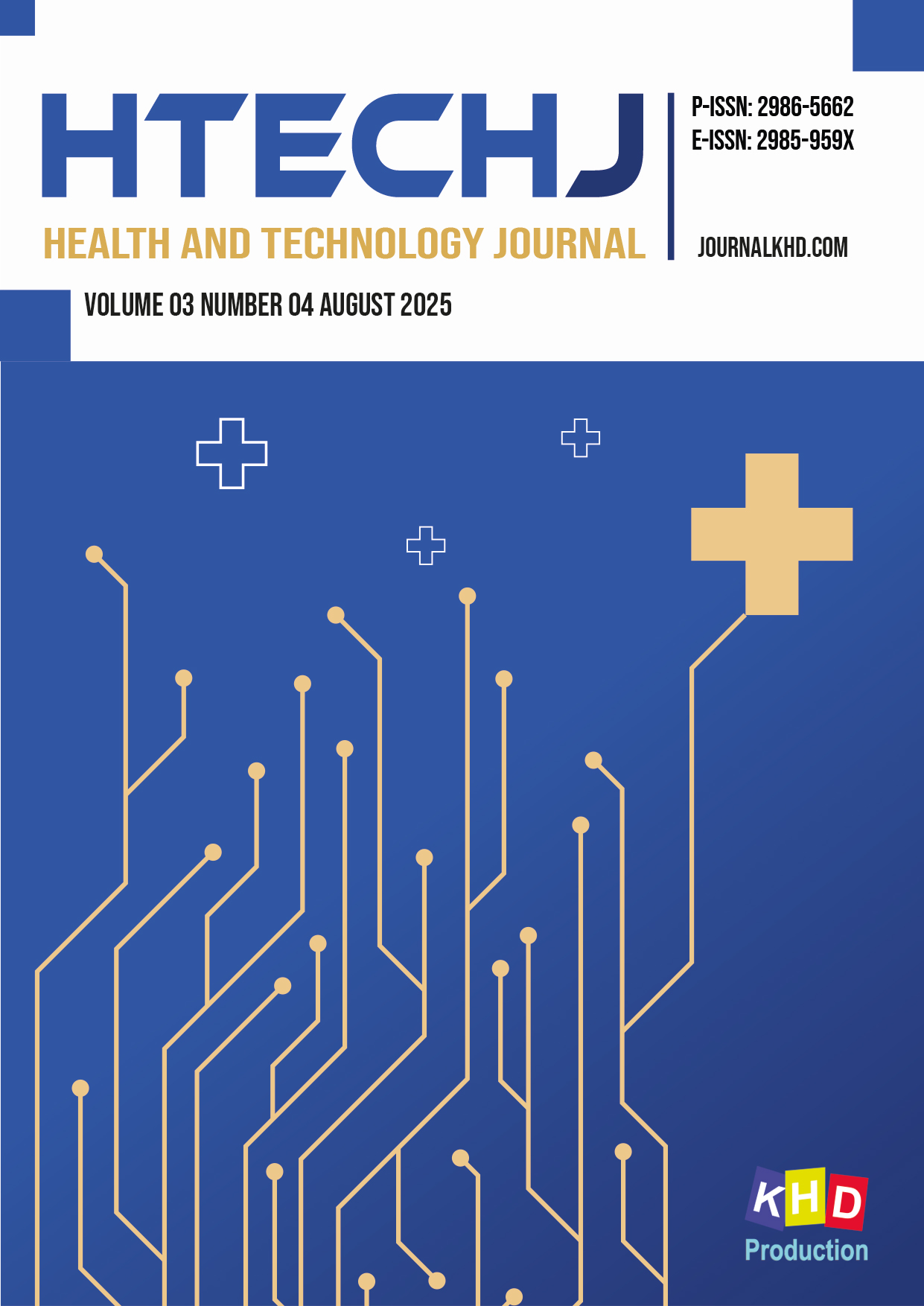The Effectiveness of the Knee-Chest Position in Midwifery Care for Correcting the Position of the Breech Presentation Fetus
DOI:
https://doi.org/10.53713/htechj.v3i4.366Keywords:
Breech presentation, pregnancy, knee chest positionAbstract
Breech presentation is an abnormal fetal position in which the buttocks or feet are located at the lower part near the birth canal, while the head is positioned above. This condition occurs in 3-4% of pregnancies and can increase the risk of delivery complications. The knee chest position is a non-invasive intervention that can help change the fetal position from breech to vertex (head down) through gravitational mechanisms and changes in pelvic space. This study aims to evaluate the effectiveness of the knee chest position in changing fetal position from breech presentation to vertex presentation in third-trimester pregnancy. This study used a case study approach with documentation of SOAP (Subjective, Objective, Assessment, Plan). The research subject was Mrs. LA at 32-33 weeks of gestational age, diagnosed with breech presentation. The knee chest position intervention was performed thrice daily for 15 minutes over 2 weeks with regular evaluations. After 2 weeks of knee chest position intervention, there was a change in fetal position from breech presentation to vertex presentation. Ultrasonographic evaluation showed successful fetal rotation without complications in either the mother or fetus. This study concludes that the knee chest position proved effective as a non-invasive intervention for managing breech presentation in third-trimester pregnancy. This research adds scientific evidence regarding the effectiveness of the knee chest position as a conservative management alternative before considering other medical interventions.
References
Azimirad, A. (2022). World Journal of Obstetrics and Gynecology. World Journal of Obstetrics and Gynecology, 12(1), 1–10. https://doi.org/https://dx.doi.org/10.5317/wjog.v12.i1.1
Bahmaei, H., Mousavi, P., Haghighizadeh, M. H., & Iravani, M. (2023). The Impact of Maternal Position in Labor on Occiput-posterior Position of Fetus and Pregnancy Outcomes in Pregnant Women Without Epidural Analgesia. Journal of Family and Reproductive Health, 17(2), 86–92. https://doi.org/10.18502/jfrh.v17i2.12871
Eprilla, Nursanti, R., Kusumawaty, & Yunike. (2021). Repositioning the Fetal Breech Location with Settings Knee Chest Position and Yoga Practice for Pregnant Women. Nursing & Healthcare International Journal, 5(6), 1–5. https://doi.org/10.23880/nhij-16000252
Ghesquière, L., Demetz, J., Dufour, P., Depret, S., Garabedian, C., & Subtil, D. (2020). Type of breech presentation and prognosis for delivery. Journal of Gynecology Obstetrics and Human Reproduction, 49(9). https://doi.org/10.1016/j.jogoh.2020.101832
Kekki, M., Koukkula, T., Salonen, A., Gissler, M., Laivuori, H., Huttunen, T. T., & Tihtonen, K. (2023). Birth injury in breech delivery: a nationwide population-based cohort study in Finland. Archives of Gynecology and Obstetrics, 308(4), 1139–1150. https://doi.org/10.1007/s00404-022-06772-1
Kenfack, B., Ateudjieu, J., Ymele, F. F., Tebeu, P. M., Dohbit, J. S., & Mbu, R. E. (2022). Does the Advice to Assume the Knee-Chest Position at the 36th to 37th Weeks of Gestation Reduce the Incidence of Breech Presentation at Delivery? Clinics in Mother and Child Health, 9, 1–5. https://doi.org/10.4303/cmch/c120601
Lalwani, A., Malhotra, N., & Suman, B. A. (2023). Breech Presentation. In Labour and Delivery: An Updated Guide (pp. 75-97). Springer Nature Singapore. https://doi.org/10.1007/978-981-19-6145-8_5
Liao, J., Shao, S., Chang, C., Chai, P. Y., Owang, K., Huang, T., Yang, C., Lee, T., & Chen, Y. (2021). Correction of Breech Presentation with Moxibustion and Acupuncture: A Systematic Review and Meta-Analysis. Healthcare, 9(6), 619. https://doi.org/10.3390/healthcare9060619
Matsushima, T., Shinmura, H., Okuda, N., Watanabe, A., Nagashima, A., Yamada, M., Harigane, E., Tsunoda, Y., Ichikawa, G., & Suzuki, S. (2022). Cephalic version by postural management in the lateral position without the knee-chest position for primiparous breech presentation: A retrospective cohort study. Journal of Obstetrics and Gynaecology Research. https://doi.org/https://doi.org/10.1111/jog.15149
Menakaya, U. A. (2021). Breech Presentation and Delivery. In Contemporary Obstetrics and Gynecology for Developing Countries (pp. 193-201). Springer International Publishing. https://doi.org/10.1007/978-3-030-75385-6_17
Morris, S., Geraghty, S., & Sundin, D. (2022). Breech presentation management: A critical review of leading clinical practice guidelines. Women and birth, 35(3), e233-e242. https://doi.org/10.1016/j.wombi.2021.06.011
Prakasiwi, S. I., Khasanah, U., & Rejeki, S. (2023). The Knowledge of Midwives About Poedji Rochjati’s Scorecard. Atlantis Press International BV. https://doi.org/10.2991/978-94-6463-132-6_42
Sánchez-Romero, J., García-Soria, V., Araico-Rodríguez, F., Herrera-Giménez, J., Blanco-Carnero, J. E., Nieto-Díaz, A., & Sánchez-Ferrer, M. L. (2020). External cephalic version: Is it an effective and safe procedure? Journal of Visualized Experiments, 2020(160), 1–7. https://doi.org/10.3791/60636
Schauer, M., Latartara, E., Alonso-Espias, M., Rossetti, E., Gebert, P., Henrich, W., & Hinkson, L. (2023). Depression, anxiety and stress in women with breech pregnancy compared to women with cephalic presentation—a cross-sectional study. Archives of Gynecology and Obstetrics, 307(2), 409–419. https://doi.org/10.1007/s00404-022-06509-0
Shinmura, H., Matsushima, T., Watanabe, A., Shi, H., Nagashima, A., Takizawa, A., Yamada, M., Harigane, E., Tsunoda, Y., Kurashina, R., Ichikawa, G., & Suzuki, S. (2023). Evaluating the effectiveness of lateral postural management for breech presentation: study protocol for a randomized controlled trial (BRLT study). Trials, 24(1), 1–9. https://doi.org/10.1186/s13063-023-07395-w
Shinmura, H., Tsunoda, Y., Matsushima, T., Kurashina, R., Watanabe, A., Harigane, E., Ouchi, N., & Suzuki, S. (2025). Evaluation of postural therapy using lateral position according to fetal back orientation on breech presentation and breech recurrence (BRLT study): An open-label randomized controlled trial. PLoS Medicine, 22(3), 1–18. https://doi.org/10.1371/journal.pmed.1004555
Todić, I., Plešinac, S., & Stefanović, T. (2024). Breech presentation-maternal and neonatal outcomes and obstetric challenges. Srpski arhiv za celokupno lekarstvo, 152(7-8), 374-378. https://doi.org/10.2298/SARH230703051T
Toijonen, A., Heinonen, S., Gissler, M., & Macharey, G. (2022). Neonatal outcome in vaginal breech labor at 32 + 0—36 + 0 weeks of gestation: a nationwide, population-based record linkage study. BMC Pregnancy and Childbirth, 22(1), 1–7. https://doi.org/10.1186/s12884-022-04547-9
Walker, S., Daelemans, C., Gerhard-Nielsen, K., Das, S., & Page, L. (2024). Variations of cervical head entrapment in vaginal breech births: New insights on how to prevent, manage and resolve. European Journal of Obstetrics and Gynecology and Reproductive Biology, 299(June), 78–82. https://doi.org/10.1016/j.ejogrb.2024.05.039
Wan, X., Zhai, J., Lu, X., Wang, X., Lilenga, H. S., Luo, M., Wang, X., Wang, X., & Zhou, Y. (2024). Effects of maternal posture and cognitive-behavioral interventions on labor outcomes in primigravidas with abnormal fetal head position: a randomized controlled clinical trial. Journal of Maternal-Fetal and Neonatal Medicine, 37(1). https://doi.org/10.1080/14767058.2024.2422448








